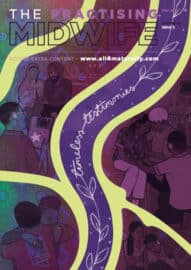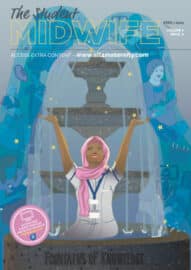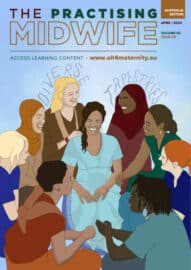Professional Midwifery Advocate (PMA) Restorative Clinical Supervision (RCS) in action- Part 2: The reflections from two PMAs/Midwifery lecturers.
Jane Tyler, University of Hull, Lisa Lachanudis, University of Hull
The need
Alongside all the anxieties in relation to the student’s studies, they also had very real concerns about their own, and their families physical and emotional wellbeing. Some students were required to self-isolate whilst others were required to home school and some students were living away from home. It has remained a very challenging time and is constantly providing an unprecedented and unpredictable environment. It was decided that the PMA’s would reach out to the students with an element of the AEQUIP model they had become familiar with but through an alternative medium.
The mechanism
Restorative clinical supervision offers an appropriate vehicle to address some of these challenges whilst enabling the students to support each other1. So how could we replicate a face-to-face group activity when we are not allowed to go outside. As the pandemic required universities to move online to ensure the student learning experience was not disrupted too much and different learning and teaching strategies were utilised (see here JISC). The University Virtual Learning Environment (VLE) had an interactive conference platform where students could attend either by camera, microphone or keyboard or a combination of all three. A VLE site was created specifically for the RCS purpose and it was important to differentiate between module supervision, personal supervision and the role of the PMA. Initially the sessions were set up for the final year student midwives as they either moved back into clinical practice or whether they remained shielding in their homes.
Talking through your keyboard
Moving into a virtual world where previously this may not have been a normal environment for students and lecturers provided challenges and opportunities. The challenges included enabling inclusivity, access to technical equipment and having a balanced approach which underpins the restorative approach. Opportunities meant there was unlimited space, no requirement to travel, flexibility and voluntary attendance. Some students had the ability to use their microphone as did the lecturers and it was important to ensure everybody could check-in. Some students did not wish to speak but were happy to type in the chat box and this was an excellent tool. The lecturers remained visible to demonstrate attentiveness and transparency.
Checking in – another dimension
What we found useful was the familiarity the students had with ‘checking in’ enabled a flexibility during this transition onto an online platform. It should be acknowledged that online check-ins do not need to be lengthy or complex, in fact Brené Brown highlights a two word approach (see here Brene Brown) Students and lecturers checked in, in no particular order but the PMAs were able to ensure that all students were heard. Some students opted to check in through their keyboard and the important thing was to ensure there were opportunities for this to happen. It quickly became apparent that they were very respectful to each other with no over-talking and they were incredibly sensitive to each other. Also, what appeared to happen was the communication and connection across the group where previously boundaries had been present.
Students displayed insight, understanding and acknowledgment of each other’s personal circumstances
Taking time and waiting enabled the students to have thinking time before typing and they found this really useful. As PMA’s we had to be mindful of acknowledging this virtual space and recognized that we had not to be afraid of the silence (see here Don’t be afraid of the silence). Whilst this silence initially felt uncomfortable, the students quickly filled the space by bringing a variety of issues, that we could never have predetermined and again by allowing for silence this enabled students to provide a restorative approach to supporting the needs identified. The students provided their agenda and became solution focused to ensure the session became meaningful. What was interesting to see, was the compassion and support offered to each other. Students displayed insight, understanding and acknowledgment of each other’s personal circumstances and the dynamic ever-changing situation they were having to exist in on a day-to-day basis. This empathic response from the students demonstrated their ability to connect and use their emotional intelligence 2 (see here Empathy).
Attendance
Attendance was voluntary and frequency was decided by the group as opposed to PMA’s – this was to ensure it was responsive rather than didactic. However, this did mean that attendance could not be predicted and that some sessions were attended by thirty individuals and some with only two. This situation required flexibility in terms of the PMA input and the use on occasion of powerful questions. The aim of these questions was to offer a potential probe that the students could choose to develop further – for example ‘what are your perceived anxieties about returning to practice?’ It is important to say here that it is the restorative group that provide responses and not the PMA’s – it is their time.
Conclusion
We felt it was imperative to collate feedback to consider whether the students had found the RCS sessions valuable. Anecdotal evidence suggests the students found this of assistance. In order to capture the benefits and value of the process in a meaningful way, we recognised a need to undertake some audit/evaluative work to support the RCS strategy. To this end, an anonymous online survey was conducted, details of which will be discussed in Part 3 alongside a student midwife’s experience of RCS on a virtual learning platform. TPM
References
1 Wallbank S. (2011) Restorative Supervision Manual. NHS Midlands and East Restorative Clinical Supervision programme, cited in Wallbank S and Woods G (2012) A healthier health visiting workforce: findings from the Restorative Supervision Programme Community Practitioner, 2012; 85(11): 20-23
2 Goleman D, Boyatzis RE, McKee A. Primal leadership: Unleashing the power of emotional intelligence. Harvard Business Press; 2013.
Jane Tyler @janetyler5












